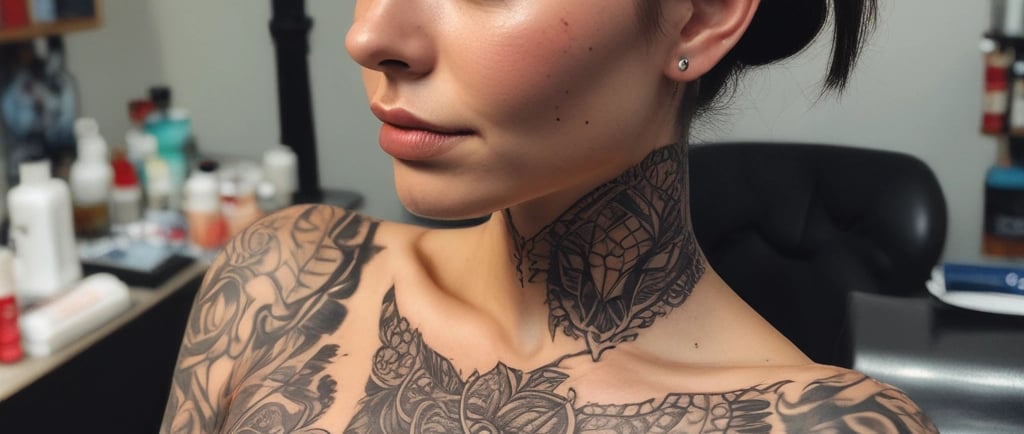Tattoo Aftercare 101: What Every Client Should Know
Learn the essential tattoo aftercare tips every client should follow for faster healing and vibrant, long-lasting ink. Discover how to care for your new tattoo properly and avoid common pitfalls.
5 min read


Introduction: Why Proper Tattoo Aftercare Matters
Immediate Steps After Getting Inked
Cleaning Your New Tattoo: Dos and Don’ts
Moisturizing and Protecting the Skin
Avoiding Sun Exposure and Swimming
What to Expect During the Healing Process
Common Tattoo Healing Issues and How to Handle Them
When to Contact Your Tattoo Artist or a Doctor
Long-Term Care for Vibrant Tattoos
Conclusion: Keeping Your Tattoo Beautiful for Life
Introduction: Why Proper Tattoo Aftercare Matters
Getting a tattoo is an exciting experience, but the process doesn’t end once the needle stops. Proper tattoo aftercare is crucial to ensure your new ink heals well, looks vibrant, and lasts a lifetime.
Without the right care, tattoos can become infected, fade prematurely, or develop scabs that damage the design. Following your artist’s aftercare instructions helps protect your skin and promotes healthy healing.
In this guide, we’ll walk you through the essential steps of tattoo aftercare—from the moment you leave the studio to long-term maintenance—so you can keep your tattoo looking its best.
Immediate Steps After Getting Inked
Right after your tattoo session, your artist will clean the area and apply a protective covering, such as a bandage or plastic wrap. It’s important to keep this covering on for the recommended time, usually a few hours, to protect your fresh tattoo from bacteria and irritation.
Once you remove the bandage, gently wash the tattoo with lukewarm water and a mild, fragrance-free soap. Avoid scrubbing or using harsh products—just use your fingertips to lightly clean the area.
Pat the tattoo dry with a clean, soft towel or let it air dry. After drying, apply a thin layer of a recommended ointment or moisturizer to keep the skin hydrated and promote healing.
Following these immediate steps sets the foundation for a smooth recovery and vibrant results.
Cleaning Your New Tattoo: Dos and Don’ts
Proper cleaning is vital to prevent infection and ensure your tattoo heals beautifully. Here are some key dos and don’ts for cleaning your new ink:
Dos:
Wash your hands thoroughly before touching your tattoo.
Gently cleanse the tattoo with lukewarm water and a mild, fragrance-free soap twice a day.
Pat dry with a clean towel or let it air dry naturally.
Use a clean, soft cloth or paper towel—avoid anything abrasive.
Don’ts:
Don’t soak your tattoo in water—avoid baths, pools, or hot tubs during healing.
Avoid scrubbing, picking, or scratching the tattoo, even if it itches.
Don’t use scented lotions, alcohol, or harsh chemicals on the tattoo.
Avoid tight clothing that can rub against and irritate the tattooed area.
By following these simple rules, you’ll help your tattoo heal faster and look great for years to come.
Moisturizing and Protecting the Skin
Keeping your tattoo moisturized is key to preventing dryness, itching, and cracking during the healing process. Use a fragrance-free, gentle moisturizer or a tattoo-specific aftercare ointment recommended by your artist.
Apply a thin layer several times a day, making sure not to over-moisturize, which can clog pores and slow healing. Your skin needs to breathe while staying hydrated.
Additionally, protect your tattoo from direct sunlight, which can fade the colors and damage healing skin. Once healed, always apply a broad-spectrum sunscreen with at least SPF 30 to preserve your tattoo’s vibrancy.
Proper moisturizing and sun protection ensure your tattoo remains bold and beautiful for years to come.
Avoiding Sun Exposure and Swimming
During the healing process, it’s crucial to avoid direct sun exposure to your new tattoo. UV rays can cause irritation, slow healing, and lead to fading or discoloration. Keep your tattoo covered with loose clothing or use a high SPF sunscreen once the skin has healed sufficiently.
Swimming in pools, hot tubs, lakes, or oceans should be avoided until your tattoo is fully healed. These environments expose your fresh tattoo to bacteria and chemicals that can cause infection or damage.
By steering clear of sun and water, you help protect your tattoo and promote smooth, healthy healing.
What to Expect During the Healing Process
Healing times can vary, but most tattoos go through several stages in the first few weeks. Initially, your tattoo might feel sore, red, and swollen—this is normal and should improve within a few days.
Around days 3 to 7, you may notice peeling or flaking skin, similar to a mild sunburn. It’s important not to pick at scabs or flakes, as this can cause scarring and color loss.
By weeks 2 to 4, the skin will continue to settle, and any residual redness or dryness should fade. Complete healing can take up to a month or more depending on the size and placement.
Understanding these stages helps you care for your tattoo properly and avoid common mistakes during recovery.
Common Tattoo Healing Issues and How to Handle Them
While most tattoos heal smoothly, some common issues can arise during the healing process:
Itching and Dryness: Mild itching is normal. Apply a fragrance-free moisturizer to soothe the skin. Avoid scratching to prevent damage.
Scabbing: Light scabbing protects the tattoo. Let scabs fall off naturally—don’t pick or peel them.
Redness and Swelling: Slight redness and swelling are typical immediately after tattooing. If redness persists beyond two weeks or worsens, it could indicate infection.
Infection Signs: Watch for increased pain, pus, excessive redness, or fever. If these occur, contact your tattoo artist or a healthcare professional promptly.
Proper care and attention can help you manage these issues and ensure a healthy, vibrant tattoo.
When to Contact Your Tattoo Artist or a Doctor
Knowing when to seek help is important for a smooth healing process. Contact your tattoo artist if you have questions about aftercare or notice unusual changes like excessive swelling, prolonged redness, or unexpected discharge.
If you experience signs of infection—such as intense pain, pus, fever, or red streaks spreading from the tattoo—seek medical attention immediately. Early treatment can prevent complications and protect your health.
Your tattoo artist is also a valuable resource for guidance, so don’t hesitate to reach out if you’re uncertain about any symptoms during healing.
Long-Term Care for Vibrant Tattoos
Caring for your tattoo doesn’t stop after the healing process. To keep your ink looking vibrant for years to come, maintain healthy skin habits:
Sun Protection: Always apply sunscreen with at least SPF 30 on your tattoo when exposed to sunlight. UV rays break down ink pigments and cause fading.
Moisturizing: Regularly moisturize your skin to keep it hydrated and supple, which helps preserve the tattoo’s appearance.
Avoid Harsh Chemicals: Minimize exposure to harsh soaps, exfoliants, or skincare products that may irritate the tattooed skin.
Healthy Lifestyle: Staying hydrated and maintaining good overall skin health supports the longevity of your tattoo.
By investing in long-term care, your tattoo will remain a vibrant and meaningful piece of art throughout your life.
Conclusion: Keeping Your Tattoo Beautiful for Life
Proper tattoo aftercare is essential for ensuring your new ink heals well and stays vibrant over time. By following the right cleaning, moisturizing, and protection practices, you can avoid common complications and preserve the beauty of your tattoo.
Remember, your tattoo is a lifelong commitment, and caring for your skin plays a major role in how it ages. Stay informed, listen to your artist’s advice, and maintain good skin habits to enjoy your artwork for years to come.
With the right care, your tattoo will remain a stunning and meaningful expression of your individuality.


